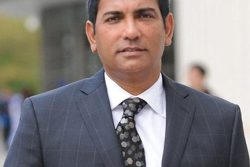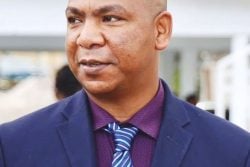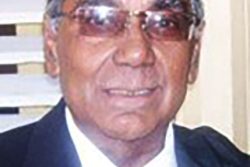In the Heart of the Sea, the 3-D film directed by Ron Howard and released in December 2015, is an interpretation of Herman Melville’s classic novel, Moby Dick.
Brilliant cinematography takes viewers aboard The Essex, a whaler, sailing out of Nantucket Island, Massachusetts, the hub of 19th century whaling, as it hunts the colossal whale. The patriarch of the large school of whales, launches a vicious counter-attack, as the sailors try to harpoon the whales. The mammal rams The Essex, almost overturning the vessel, whilst leaving a huge hole in the hull. The crew is forced to abandon ship in three lifeboats. The whale stalks and torments the boats, eventually destroying one in a fit of rage. Captain and crew are reduced to six men in two boats hopelessly adrift for 90 days, under the sweltering sun, no food or water, in a desert of water, the winds non-existent, in the doldrums.
“The Doldrums, an equatorial belt of calms area around the earth centered slightly north of the equator, between the two belts of tradewinds. The large amount of solar radiation that arrives at the earth in this area, causes intense heating of the land and the ocean. This heating results in the rising warm, moist air; low air pressure; cloudiness; high humidity; light, variable winds; and various forms of severe weather, such as thunderstorms and squalls. Hurricanes originate in this region. The doldrums are also noted for calms, periods when the winds disappear, trapping sailing vessels for days or weeks”- The Columbia Electronic Encyclopedia.
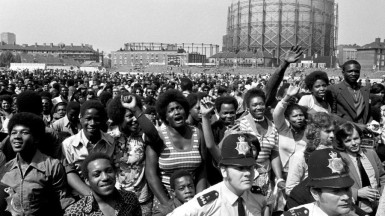
April 26, 1973, last day of the drawn Fifth Test match, West Indies versus Australia, at the Queen’s Park Oval, Port-of-Spain, Trinidad. It’s now twenty Tests, four years and fifty-four days and counting, since the West Indies saga in the doldrums begun. The last victory was in the First Test at Eden Park, Auckland, New Zealand, where they scored 348 for 5, in five and three-quarter hours, to beat the clock. Seymour Nurse (168) and Basil Butcher (78 n.o.) led the spectacular run chase.
It was 6.10 pm, March 3, 1969.
The Ninth West Indies team to tour England arrived in early June, 1973, for a Three-Test Series (half-tour), following in the wake of the New Zealanders 2-0 loss to the hosts. On May 31, for the first time since World War II, Glenn Turner, the Kiwi opening batsman had joined the Exclusive Batting Club of “1,000 Runs before the end of May”, a feat achieved only seven times before (twice by Don Bradman), and once since, in 1988, by Graeme Hick.
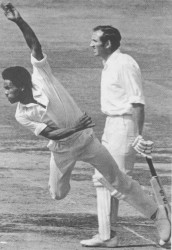
Rohan Kanhai had replaced Garry Sobers as Captain for the previous series, the 2-0 loss to Australia. His team had plenty of experience in English County cricket: Kanhai, Lance Gibbs (vice-captain), Deryck Murray, Alvin Kallicharran (Warwickshire), Roy Fredericks (Glamorgan), Clive Lloyd (Lancashire), Vanburn Holder (Worcestershire), Bernard Julian (Kent) and Keith Boyce (Essex). Stephen Camacho, Maurice Foster and Grayson Shillingford had been members of the 1969 team which had lost 2-0, in the first half of the summer and David Murray had visited England in 1970 with the West Indies Young Cricketers (WIYC) team. Lawrence Rowe, the spinners Inshan Ali and Elequemedo Willett were the only players devoid of knowledge of the English conditions.
West Indian fans had good reasons for optimism. The previous winter, England had played in the Asian sub-continent, under the captaincy of Tony Lewis (probably England’s last amateur Captain), losing 2-1 to India in a five-Test rubber and drawing all three Tests in Pakistan. Ray Illingworth, Captain since the 1969 encounter with WI, was in charge again, after missing the aforementioned tour, but wasn’t fully endorsed by the highest levels for the captaincy. In 1971, England had lost 1-0 to India, and in 1972 had retained the Ashes with a 2-2 draw; both encounters being in England.
The flames of hope had been flickering slightly in the past two series, both at home, for the West Indies. In 1972, all five Tests were drawn against
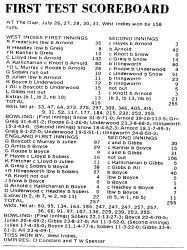
New Zealand, with WI failing to capitalise their advantage on three occasions, moreso in the last Fifth Test at Port-of-Spain, April 20 – 26. The visitors needing to score 401 to win were 188 for 7, with forty-five minutes and twenty overs remaining, and it was only a matter of time before they capitulated. The eighth wicket pair of Ken Wadsworth and Bruce Taylor imposed their wills on the match, and defied WI as New Zealand crawled to 253 at the close of play. In the Third Test at Kensington Oval, Barbados, March 23 – 28, the West Indies had displayed great fighting spirit. Dismissed for 133 in their first innings, they were 297 for 5, at the start of the final day. Trailing by 289 runs, WI were in effect, 8 for 5. Charlie Davis (183) and Garry Sobers (142) shared a sixth wicket partnership of 254, as WI reached safety at 564 for 8.
The Third Test at the Queen’s Park Oval, March 23 – 28, 1973, versus a tough Australian side led by Ian Chappell, encapsulated the total frustrations experienced by cricket fans in the Caribbean. After trailing by 52 runs on first innings batting one short (Lawrence Rowe having pulled ligaments in an ankle on the first day) WI fought their way back into the contest and had Australia struggling at 231 for 8. Lusty hitting by the fast bowlers Jeff Hammond and Max Walker pushed the total to 281, as WI employed defensive tactics against the weaker batsmen. Chasing a target of 334 runs, WI were 188 for 3, at the start of the final day, with Kallicharran 61, and Lloyd 1, at the wicket. At lunch, they had progressed to 268 for 4, with Kallicharran and Maurice Foster holding the fort. Chappell later conceded that he had given up any hope of removing Kalli, who was applying himself to the task on the turning wicket. First ball after the break from Walker, Kalli played a casual stroke, got an edge and provided Rod Marsh, the wicketkeeper with the easiest of catches. His innings of 91 in 289 minutes had promised the elusive victory. It was not to be, as the inevitable collapse took place, and WI lost by 46 runs.
In the next Test, at Bourda, April 6 -11, after compiling 366, led by Lloyd’s 178, they had taken a first innings lead of 25. The pitch had been re-laid the previous year and the bounce was very uneven. The hosts began the fourth day on 3 without loss on a deteriorating wicket, looking to set a challenging score for the Aussies. An hour after lunch, following a bunch of reckless shots (save Kanhai who was lbw to a shooter from Walker), the West Indies were all out for 109. Australian openers Keith Stackpole and Ian Redpath got the required 135 runs with no resistance. It would be the sixth loss in 19 winless matches.
Lady Misfortune
The loss of the pace duet of Wes Hall and Charlie Griffith in 1969, still lingered, as the fast bowling attack lacked that extra yard or two of pace. The batting line-up had the talent and experience for Test cricket, but didn’t display the application and dedication required at this level. Could they put it together this tour?
Lady Misfortune arrived in the second first-class match of the tour, against Hampshire at Southampton, June 23, 25 and 26. In the second innings, 15 minutes before the close on the second afternoon, opener Camacho was struck in the face whilst attempting to hook a young fast bowler in his debut county season. He sustained a fractured cheekbone and had to retire hurt. Camacho, who had been expected to open with Fredericks, took no further part in the tour, in fact, it was the end of his Test career, as he was never the same again. He had become an early entry in the long list of batsmen hit by Andy Roberts of Antigua.
The West Indies beat Hampshire by 174 runs, following a draw with Essex. At Eastbourne, June 27 – 29, a strong D H Robins’ XI beat WI by ten wickets, for their only first-class loss of the tour, as England openers Geoffrey Boycott and Dennis Amiss shared an unbroken stand of 172. The D H Robins’ XI also included Test players, Graham Roope, John Hampshire, Tony Greig, Bob Taylor (Eng), Mushtaq Mohammed, Intikhab Alam (Pak) and Bishen Singh Bedi (India).
Kallicharran followed up his 113 against the D H Robins XI, with 124 against Nottinghamshire, at Trent Bridge, on June 30 and July 2 and 3. An opening partnership of 151, between Fredericks (82 n.o.) and Rowe (84), led to a nine-wicket victory, as WI cruised to 166 for 1. At Lord’s, July 4 – 6, West Indies batted once in the drawn game with Middlesex and compiled 341 for 5, with good knocks from Foster 95, Lloyd 78 and Kalli 60. In Swansea, Wales, July 7 – 10, Glamorgan was beaten by an innings and 11 runs. WI scored 437 for 7 declared. Kallicharran (135), Fredericks (91), Lloyd (55), Rowe (48), and David Murray (40 n.o.) were the leading scorers. Willett grabbed 8 wickets for 73 in the first innings.
Sussex hosted the West Indian team from July 14 -17 at Hove. Sussex batting first were 97 for 5, when England fast bowler John Snow came to the wicket. In his usual belligerent manner, he swatted the ball around and gave a hard chance to Kallicharran at mid-off. Two balls later, he repeated the shot and Kalli accepted the catch.
On the first chance, he had hurt his hand and now he left the field. He returned later from hospital, the broken middle finger on his hand in a splint, his place for the first Test 12 days away in doubt.
After Camacho’s injury Rowe had filled the slot. His ankle injury was not fully healed and was becoming more of a bother as the tour progressed, and replacements were sought. Worcestershire was approached, and after negotiations, Ron Headley, son of West Indies Great George Headley was released for the rest of the tour. Garry Sobers had missed the Australian series following knee surgery. The rigours of the continuous globetrotting life of a professional cricketer had taken its toll. His (then) world record streak of 85 consecutive Test matches had come to an end and he had missed a Test match for the first time since his debut in 1954. The summer of 1973 found him playing for Nottinghamshire in the County Championship. On July 17, WI Manager Esmond Kentish confirmed that the World’s Greatest All Rounder had been approached about his availability for the Test series.
The Sussex match was drawn, with Lloyd (102 n.o.), Kanhai (64), and Rowe (54), enjoying the bowling. Headley made his debut in the Kent game, July 18 – 20, at Canterbury. Another drawn contest with centuries for Foster (127) and David Murray (107 n.o.) in the first innings, followed by 97 from Fredericks and Lloyd’s 85 in the second. The last game before the first Test was against Young England, July 21 – 23, at Old Trafford, Manchester. Rain washed out the first day completely and limited the contest to only 138 overs. Kanhai got 59 n.o., as Lloyd suffered a badly bruised foot courtesy of a shooter from the young Warwickshire fast bowler and future English Captain Bob Willis. Other notable names to appear in that game were Derek Randall, Mike Hendrick and John Lever.
The Oval
The historic Kennington Oval located in South London was the site of the first ever Test match in England (vs Australia) in September 1880 and the birthplace of the legend of the Ashes in August 1882, when England were dismissed for 78 runs, 7 short of the target. Traditionally the venue for the last Test of the summer, England held a 5-2 lead in Tests versus the West Indies. On July 24, Kentish confirmed Garry Sobers’ inclusion in the squad for the Test.
Thursday, July 26, 1st Day.
West Indies XI; Fredericks, Headley, Kanhai, Lloyd, Kallicharran, Deryck Murray, Sobers, Julien, Boyce, Ali, Gibbs.
England XI; Boycott, Amiss, Roope, Frank Hayes, Keith Fletcher, Greig, Illingworth, Alan Knott, Snow, Geoff Arnold, Derek Underwood.
Headley, Julien and Hayes the Lancastrian who was a member of the Young England Team at Old Trafford were making their Test debuts.
Kanhai won the toss and elected to bat in dull, grey overcast conditions which supported the swing and cut of Arnold and Greig. Fredericks and Headley added 33 in 81 minutes before the latter fell lbw to Greig, with the former following in like manner against Arnold just before lunch for 35. When Greig bowled Kanhai for 10, WI were 64 for 3, with England having the initiative. Kallicharran, playing with the damaged hand joined Lloyd 20 minutes after lunch, just as the sun pushed through the clouds. In three hours and fifteen minutes, they launched a counter assault with an array of strokes whilst adding 208 for the fourth wicket. Kalli then chased a wide delivery from Arnold, his first with the second new ball and knocked a catch to Knott behind the stumps just before close of play. Shades of Port-of-Spain! His innings of 80 included 13 fours. At stumps WI were 275 for 4, with Lloyd (132) and Murray (1), and seemed poised for a huge total. Lloyd’s fifth Test century brought the inevitable running on to the field by over-exuberant West Indians and contained 15 fours and two sixes.
Friday, July 27, 2nd Day
The day began once again in dull and cloudy conditions. Lloyd was lbw to Arnold with the first ball of the day. No doubt “Here we go again” thoughts started to permeate the minds of West Indian fans. Garry arrived with the expectations of a packed crowd, many of them from the Caribbean, resting on his shoulders. Together with Murray, he battled the swing of Arnold and Company for an hour, before he was run out by a brilliant throw from Amiss from mid-on. When Julien became Arnold’s third lbw victim, a few minutes later WI were 307 for 7.
Keith David Boyce then joined Murray. At the start of the year, Boyce had played a solitary against India in 1971. When Julien had his arm broken whilst batting in the nets, the day before the Second Test against the Australians in Barbados, Boyce was chosen, as there was no time to fly in a replacement. An impressive performance in four Tests, coupled with his county experience, made him an automatic selection for England. Over the next two and a quarter hours, he played steadily in the familiar conditions, mixing bold aggression with cautious defence. His decisive knock of 72, included 6 fours and a superb straight off Greig, into the pavilion seats. Little Inshan Ali contributed 15 in a ninth wicket stand of 59 in 66 minutes. When Underwood bowled Boyce, WI had compiled 415. Arnold, 5 for 113 was the pick of the English bowlers.
Boycott and Amiss began England’s innings, 30 minutes before tea, with Garry and Boyce sharing the new ball. At the close, England were 117 for 2, with Boycott (55) and Hayes (14), the latter having dispatched the last two balls of the day from Ali, for a six and a four. Amiss and Roope were both bowled by Boyce.
Saturday, July 28, 3rd Day
On a typical English day when sun never shone, West Indies snatched the initiative. Sobers celebrated his 37th birthday by having Hayes caught by Lloyd at third slip. Julien, left hand, fast medium, in the mould of Sobers, replaced Garry and quickly accounted for Fletcher and the dangerous Boycott. The latter, glancing a catch to Murray for a solid 97 in a tad over four hours, which included 13 fours and 1 six. 185 for 5 just before lunch. Greig and Illingworth batting sensibly, added 62 in an hour before the birthday celebrant had Illingworth lbw for 27, and then caught Greig off Boyce for 38. Snow was bowled first ball and three wickets had fallen with no
addition to the score. When Underwood was caught by Headley off Sobers, England had lost five wickets for 10 runs in 30 minutes, off 8.1 overs of the second new ball. Boyce took 5 for 70, whilst Sobers’ 3 for 27 had come off of 22.1 overs including 13 maidens.
West Indies had secured a lead of 158 runs. An hour into their second innings, they were 52 for 3. Fredericks, Kanhai and Lloyd, out to poor shot selection. Headley (40) and Kallicharran (23) applied themselves to reach 95 without further loss at the close.
Sunday, July 29, Rest Day
Monday, July 30, Fourth Day
In front of another packed crowd of 26,000, many of them of Caribbean origin, WI asserted their superiority in the brilliant sunshine. Headley (42) and Kallicharran (80) occupied the crease for almost three hours each. Sobers was ninth out for a solid 51 in two and a half hours. The second innings total of 255 gave England a target of 414 runs. Snow, Arnold and Illingworth took 3 wickets each.
After Boyce had Amiss caught by Kanhai at slip, Gibbs’ accurate spin bowling took the heart out of the line-up. Boycott and Roope were both deceived in flight, and gave stiff return catches. Kallicharran accepted a catch at deep square leg from Fletcher off Gibbs, who then caught Greig at second slip, giving Ali his first wicket in the match. 107 for 5. Hayes (37) and Underwood the night watchman (3) saw England to 126 for 5 at the close.
Tuesday, July 31, Fifth Day
Apart from a seventh wicket partnership of 93 in two hours, between Hayes and Illingworth, there was no stopping the West Indies, or rather, Boyce. Just before lunch, he bowled Illingworth, for 40 and then got Knott, lbw for 5. The score was 239 for 8. The victory was completed, 20 minutes after lunch, when John Snow was clean bowled by Boyce for 1. England had been dismissed for 255, giving the West Indies victory by 158 runs. The large West Indian contingent in the crowd, as expected, invaded the playing field and gathered in front of the landmark pavilion, shouting for their team. It was their first victory in England since 1966 and the first at the Oval since 1963, made possible by wonderful team effort.
The young Lancastrian, Hayes, was unbeaten on 106. He was never really bothered by the spin or pace and had duly earned a test century on debut, which was well received by the appreciative crowd. Hayes was only the fifth Englishman to achieve the feat, since World War II. Boyce’s second innings haul, of 6 for 77, had given him match figures of 11 for 147. It was the best bowling analysis, by a West Indian in Test Cricket. Boyce and Hayes won the respective Man of the Match awards.
Keith Boyce, the prototype of the modern day T20 player, had proven he was a genuine Test player. His fiery pace bowling, at times, as fast as Hall and Griffith and his exuberant batting made him an invaluable all-rounder. His fielding prowess drew comparisons with the Australian, Paul Sheahan. He was a joy to watch as he chased balls like an Olympic sprinter, his pick-ups were clean and his returns, fast and accurate.
The West Indies had set sail, with the winds of ‘the Man from Essex’.
Trivia question. Can you name the six left-handed batsmen in the West Indian side at the Oval, in 1973? (Careful!)


